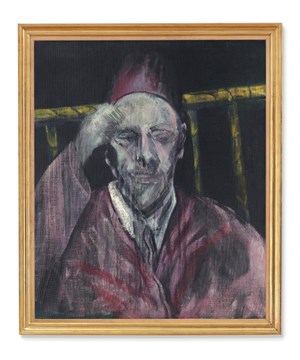
Bacon’s Popes are not only the centrepiece of all his paintings in the 1950s but a centrepiece of the whole of 20th-century art. Michael Peppiatt.
Bacon’s Popes are not only the centrepiece of all his paintings in the 1950s but a centrepiece of the whole of 20th-century art. Michael Peppiatt.
Francis Bacon’s Head with Raised Arm (1955, estimate: £7,000,000 – £10,000,000) will be unveiled for the first time in over half a century as part of Christie’s Post-War and Contemporary Art Evening Auction, a highlight of London’s Frieze Week auctions. Last exhibited in 1962 at the Galleria Civica d’Arte Moderna, Turin, the work was acquired by the present owners the following year, and has remained hidden from public view ever since. The work’s location was listed as ‘unknown’ in the most recent version of the catalogue raisonné published last year by Martin Harrison. Riddled with quiet introspection and human tension, it belongs to a group of nine surviving paintings depicting the then-incumbent, Pope Pius XII. With four held in museum collections, and a further on permanent loan, Bacon’s portraits of the living Pope are among his most profound. The work will be on view from 8 September, Christie’s Rockefeller Center, New York; 18 September, Christie’s Hong Kong; and 30 September 2017 at Christie’s King Street as part of the Post War and Contemporary Art Evening Auction that will take place on the 6 October 2017.
The Pope’s face and arm flicker like moving images caught on camera, animated by a veil of rapid hairline striations. Combed vertically with a fine brush over layers of colour, the work demonstrates Bacon’s dialogue with photography in his bid to capture what he termed ‘the trail of the human presence’. Rare for its closely-cropped depiction of the pontiff’s head and shoulders, the present work confronts its subject on a piercing, intimate scale. It is one of only two Popes executed in Bacon’s jewel-like 24-by-20-inch format, aligning it with his first small portrait triptych of 1953. Elected to the papacy in 1939, Pius’s reign had spanned the Second World War, famously inciting accusations of silence in the face of atrocity. As the Church and media sought to uphold his infallibility, the artist cast him as a fragile, flawed being, tortured by the weight of his grand station.
Pursued over nearly two decades, and numbering more than fifty canvases, Bacon’s Papal portraits are widely regarded as his finest achievements. These works were his first and most significant existential enquiries, and stand today among the foremost images of the twentieth century. ‘It’s true, of course, the Pope is unique’, he explained. ‘He’s put in a unique position by being the Pope, and therefore, like in certain great tragedies, he’s as though raised onto a dais on which the grandeur of this image can be displayed to the world’ (F. Bacon, quoted in D. Sylvester, The Brutality of Fact, London 1990, p. 26).

ArtDependence Magazine is an international magazine covering all spheres of contemporary art, as well as modern and classical art.
ArtDependence features the latest art news, highlighting interviews with today’s most influential artists, galleries, curators, collectors, fair directors and individuals at the axis of the arts.
The magazine also covers series of articles and reviews on critical art events, new publications and other foremost happenings in the art world.
If you would like to submit events or editorial content to ArtDependence Magazine, please feel free to reach the magazine via the contact page.